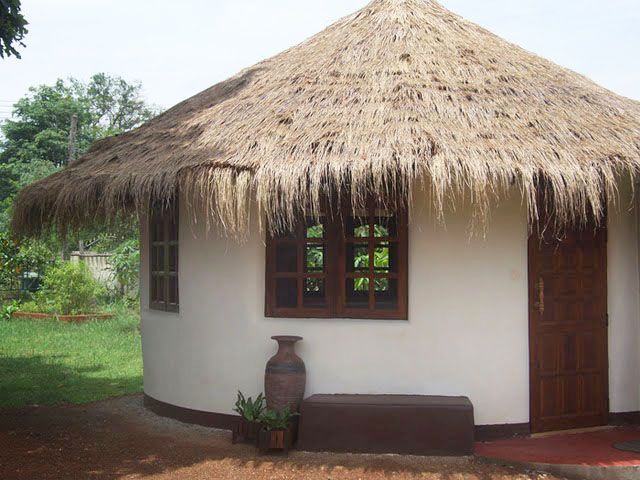Regular readers of this blog have been following the course of building an Earthbag Roundhouse that was initiated last April at one of Owen Geiger’s workshops in Thailand. That project is now finished and the result is stunning!

I am pleased to report that a complete project page has been assembled at earthbagbuilding.com that takes you through the entire process of building this lovely structure. In addition to the many photos and descriptions of what was done, we have added many short videos that provide even more detail.
So for an enjoyable browse, and further education, I encourage you to take a look.

Owen, this is a wonderful presentation!
Did you mention the wall height and diameter? I want to see others using thatch panels- thanks for showing it to us in the video.
And are there easy links to more information about the roof structure and pressure ring?
The wall height is about 9′. The interior diameter is 15′. More specs: http://earthbagplans.wordpress.com/2010/10/23/roundhouse-studio/
The roof is extremely simple. Peeled roof poles are bolted to hurricane ties in the concrete bond beam. The top ends of the poles are bolted to the compression ring in two places.
The photo of the compression somehow got lost. The only good photos show it installed in place. Look closely and you should be able to figure it out. It’s made of two circles of steel. One circle is vertical. The other one is welded to it and angles down like a skirt. There are 16 evenly spaced holes drilled in each.
As I’ve said before, this is a beautiful house and I love it.
On an unrelated note, do you know the status of the http://www.okokok.org website? I’ve referred to it often for info, but it is now unavailable. This is Kaki Hunter and Doni Kiffmeyer’s website, isn’t it? Thanks.
Thank you very much. I probably need to add it’s also cool and comfortable inside, even in our hot climate. The thick walls, lots of windows and high ceiling all work together efficiently.
I heard that Doni and Kaki closed their website.
Owen, the Roundhouse is absolutely beautiful and inspiring as well!
For a more extreme climate, I wonder what a more insulative earthbag fill and an insulated roof system would add to the cost?
It all depends on the cost of the fill material. Builders in Crestone, Colorado, for instance, have a scoria mine about 1-2 hours away. This helps make scoria affordable and so it’s used extensively there in new construction.
In many areas cellulose insulation is the most practical/affordable roof insulation. Wall insulation is trickier because it has to support the structure. You can google cold climate earthbag and insulated earthbag to read about various techniques that are possible. For many, this may require adding a layer of insulation on the outside of earthbags walls.